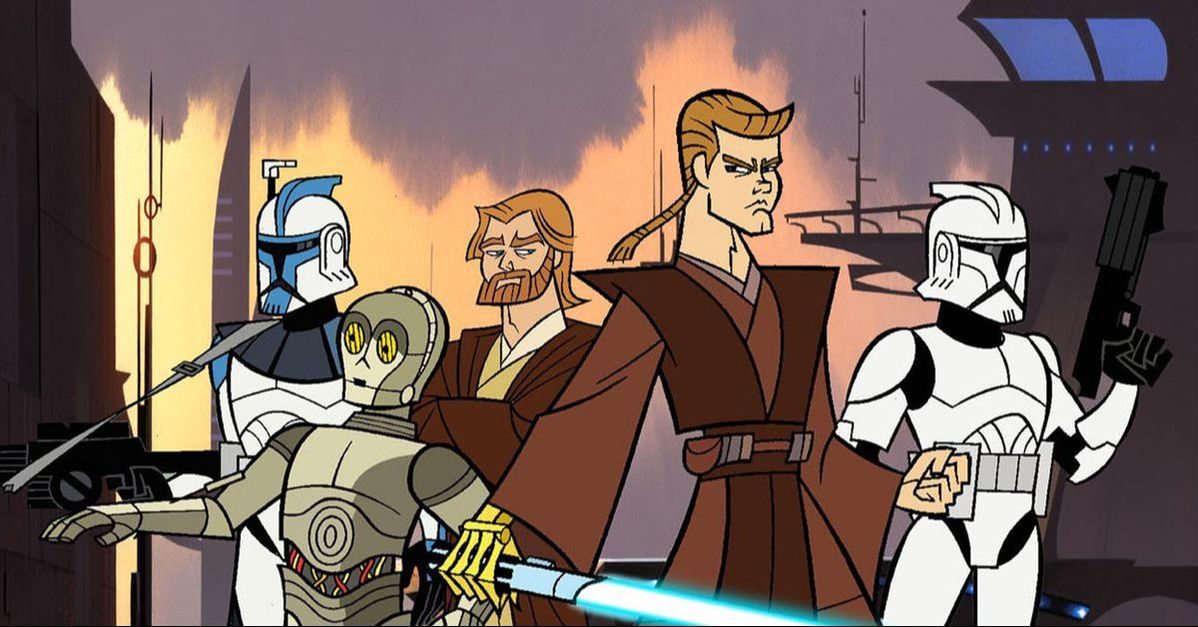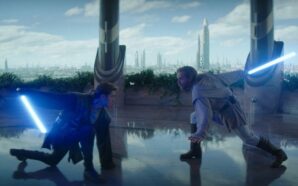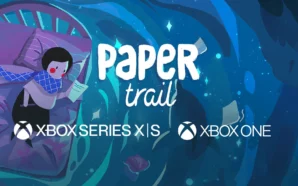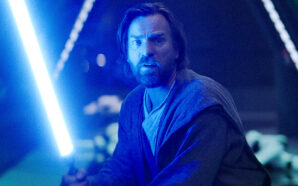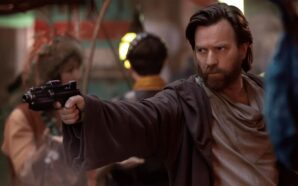“Like fire across the galaxy, the Clone Wars spread”. Before the galactic conflict first teased in the original Star Wars was explored across seven seasons of 3D animation, there was… another. In 2002, upon the release of Attack of the Clones, Hasbro asked Lucasfilm to develop a Star Wars animated series that would increase toy sales and eventually promote Revenge of the Sith. A deal was struck with Cartoon Network and Genndy Tartakovsky of Samurai Jack fame was brought in to develop the show. Star Wars: Clone Wars was born; a series of 5-minute 2D animated shorts focusing on Jedi during the eponymous conflict. The beloved show, retrospectively seen as a pilot for the 3D series that would follow, has now arrived on Disney+, offering fans who have never seen it before, such as myself, a new Star Wars adventure.
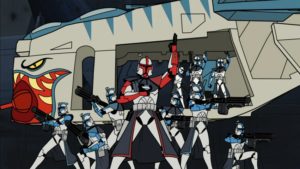 The first two seasons of the show have been edited together into a 69-minute “Volume 1” and it’s an exhausting watch. These shorts are designed to be brief punches of action and so editing them together overwhelms the senses. I had to watch it in three parts and take breaks from the constant barrage of lightsabers and blaster bolts. I wish the shorts were available to watch individually rather than this huge block of war. The format betrays the nature of the show. Unlike the later 3D series, Tartakovsky’s Clone Wars is a minimalist action serial. 5-minute snapshots of the battle raging across the galaxy. Dialogue is minimal and there’s no character work that can’t be explored with a weapon in hand because there’s no time for anything but action.
The first two seasons of the show have been edited together into a 69-minute “Volume 1” and it’s an exhausting watch. These shorts are designed to be brief punches of action and so editing them together overwhelms the senses. I had to watch it in three parts and take breaks from the constant barrage of lightsabers and blaster bolts. I wish the shorts were available to watch individually rather than this huge block of war. The format betrays the nature of the show. Unlike the later 3D series, Tartakovsky’s Clone Wars is a minimalist action serial. 5-minute snapshots of the battle raging across the galaxy. Dialogue is minimal and there’s no character work that can’t be explored with a weapon in hand because there’s no time for anything but action.
While the Clone Wars will go on to be seen in Revenge of the Sith – although not to the ‘seven battles on seven worlds’ extent that Lucas was hoping – at the time of the microseries’ release war to this scale had never been seen in Star Wars. Watching it today, it’s the scale that holds up the most. Even big battle episodes of the 3D series, such as Landing at Point Rain, don’t come close to what is pulled off in this show. The 3D series always struggled with the sheer cost of using so many digital assets in a single episode but that isn’t an issue with the 2D show. Scale is much easier to pull off. We see literally hundreds of ships do battle and legions of troops race across the screen, all firing their weapons. Sometimes the soldiers are nothing but tiny dots on the screen and I love the use of huge locations that intentionally dwarf characters.
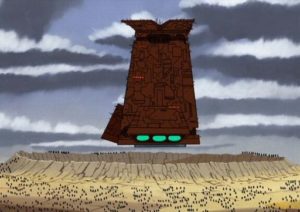 The show, as edited together, flicks back-and-forth between a number of galactic battlegrounds. While each location is different and well-realised, a very clear formula becomes apparent. We spend some time just watching clones shoot at droids and whichever Jedi is in command of that particular squad perform lightsaber acrobatics before suddenly a villainous superweapon is revealed that our heroes need to destroy, which they ultimately do. My favourite is a giant punching ship which floats over the battlefield and thrusts a ginormous metal fist against the ground to squish any unfortunate soul caught beneath. It’s also worth noting that absolutely anything that gets shot, whether it be a person, an object, or a wall, creates the same red explosion. The most unnecessary of these repetitive battles is Kit Fisto’s assault on Mon Cala, something later adapted in the 3D show, but I’ll allow this unconnected escapade just because of how cool it was seeing Star Destroyers land and then float on water.
The show, as edited together, flicks back-and-forth between a number of galactic battlegrounds. While each location is different and well-realised, a very clear formula becomes apparent. We spend some time just watching clones shoot at droids and whichever Jedi is in command of that particular squad perform lightsaber acrobatics before suddenly a villainous superweapon is revealed that our heroes need to destroy, which they ultimately do. My favourite is a giant punching ship which floats over the battlefield and thrusts a ginormous metal fist against the ground to squish any unfortunate soul caught beneath. It’s also worth noting that absolutely anything that gets shot, whether it be a person, an object, or a wall, creates the same red explosion. The most unnecessary of these repetitive battles is Kit Fisto’s assault on Mon Cala, something later adapted in the 3D show, but I’ll allow this unconnected escapade just because of how cool it was seeing Star Destroyers land and then float on water.
This first volume is set just a couple of weeks after Attack of the Clones and everything is based very much on the end of that movie. It had to be considering Revenge of the Sith was nothing but notes at this point and the show acts as a fascinating time capsule. The Geonosian ships from Attack of the Clones are used in the show as the main separatist fighters rather than tri-fighters or vulture droids, which is odd but understandable; coming out of the second prequel I guess you would presume that ship is the new CIS vessel rather than specific to one race as we know it to be today. Character designs are also based on Attack of the Clones. Anakin looks the same and Obi-Wan retains his wonderful Jedi mullet, although he also has his thicker beard already and that combination may be my favourite Obi-Wan look. He even wears a clone helmet when going into battle rather than just the armour plates he sports in the 3D show.
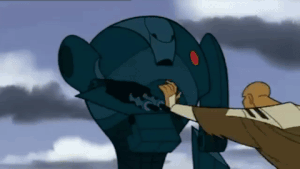 However, a sizable element I dislike in the microseries is that the Jedi are essentially superheroes. The force is very much unleashed and they can do huge, remarkable things very easily. These are the Jedi that fans wanted to see in the movies, crashing flagships with the flick of a finger and force-punching an entire droid army into nothing but a pile of bolts, but that doesn’t fit the Jedi of the prequels. The show misses the point that this is a flawed order and that the Jedi’s power is currently suppressed. These abilities make more sense in the High Republic, but even then they need to be taken down a few power levels. But this is a cartoon after all and the storytelling medium demands extraordinary feats. Mace, the biggest offender, is seen through the eyes of a child so maybe we can chalk some of his more preposterous actions up to an overactive child’s imagination. Lightsabers also have the habit of getting stuck in things which doesn’t make much sense either because surely the blade would just cut and fall through things endlessly.
However, a sizable element I dislike in the microseries is that the Jedi are essentially superheroes. The force is very much unleashed and they can do huge, remarkable things very easily. These are the Jedi that fans wanted to see in the movies, crashing flagships with the flick of a finger and force-punching an entire droid army into nothing but a pile of bolts, but that doesn’t fit the Jedi of the prequels. The show misses the point that this is a flawed order and that the Jedi’s power is currently suppressed. These abilities make more sense in the High Republic, but even then they need to be taken down a few power levels. But this is a cartoon after all and the storytelling medium demands extraordinary feats. Mace, the biggest offender, is seen through the eyes of a child so maybe we can chalk some of his more preposterous actions up to an overactive child’s imagination. Lightsabers also have the habit of getting stuck in things which doesn’t make much sense either because surely the blade would just cut and fall through things endlessly.
If the Jedi are superheroes, they need a supervillain to match them and so the show introduces the bounty hunter Durge. He’s pretty cool but his regenerative powers and design do make him seem like a comic-book villain and he just doesn’t feel like a Star Wars character. Thankfully, the series also offers Asajj Ventress and she’s the best thing about the whole volume. The Sith wannabe is first seen fighting in a gladiatorial arena with Dooku scouting for a new apprentice, which is the best episode of the show, offering great action inflected with pulpy silliness. Asajj is hired for the job and, despite Lucasfilm stating otherwise, this episode is canon to me. What’s missing from the 3D series is the early days of the Clone Wars and character introductions (the series beginning with Asajj already a known presence and having met Obi-Wan and Anakin beforehand) and this is a great origin for her which perfectly fits.
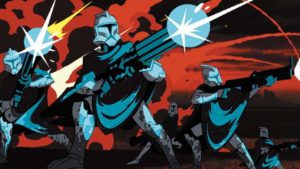 While the Jedi characters are very much the focus of the show, there are a few scenes in which the Clones are given time to shine, and by “time to shine” I mean blow stuff up. The Clones are shown to be so in sync with each other, on account of them being identical, that they don’t need to talk among themselves, instead relying on intuition and the occasional hand signal to move and fight as an unstoppable group. Sadly however, this also means they are treated much the same way as they are in the films: tools without personality. Exploring the clones as individuals is possibly the greatest strength of the 3D series and that work is currently paying off in The Bad Batch. In contrast, the microseries isn’t interested in the clones for anything other than action, but considering the serial style of the show and the episode length that is unsurprising.
While the Jedi characters are very much the focus of the show, there are a few scenes in which the Clones are given time to shine, and by “time to shine” I mean blow stuff up. The Clones are shown to be so in sync with each other, on account of them being identical, that they don’t need to talk among themselves, instead relying on intuition and the occasional hand signal to move and fight as an unstoppable group. Sadly however, this also means they are treated much the same way as they are in the films: tools without personality. Exploring the clones as individuals is possibly the greatest strength of the 3D series and that work is currently paying off in The Bad Batch. In contrast, the microseries isn’t interested in the clones for anything other than action, but considering the serial style of the show and the episode length that is unsurprising.
There is one storyline that does actually feel like a precursor to the storytelling style of the 3D Clone Wars series which features Yoda and Padme traveling to Ilum. It plays out over three consecutive episodes and, when edited together, they work like an episode of the later, more focused show. I love any time Ilum makes an appearance, even more so now that we know for certain that its fate is to become Starkiller Base. It’s still an action-heavy story but also focuses more on character and lore. Padme is underserved by the show as a whole and so she has at least some screentime here with her and Yoda making for an interesting pair. While the series largely ignores the Jedi’s flaws, here Yoda is shown in a very negative light when he forces Captain Typho to do his bidding with a mind trick. The story also features the only time I can think of when Dooku betrays his former Jedi brethren by revealing secrets known only to the Jedi when separatists appear on Ilum to destroy the Kyber crystals. I wish the 3D show featured a storyline where Dooku uses Jedi knowledge for Sith purposes.
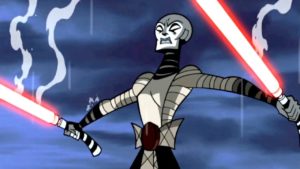 Among the endless warring, the show’s narrative spine is that of Obi-Wan and Anakin’s relationship and what little character drama there is with them is done well. Kenobi thinks to himself about how unprepared he is and his struggles to live up to Qui-Gon’s dying wish while Anakin’s impatience and anger gets the better of him. He rushes headfirst into a fight with Ventress against orders, tired of being held back. Anakin and Asajj’s lightsaber duel is spectacular. Tartakovsky relies again on his samurai influences as the fight spends as much time in the quiet build up to violence as it does with the clash itself. The rain sizzling on the lightsabers is a brilliant touch. Ultimately, Anakin gives in to his anger and, shockingly, kills Ventress, ending with the powerful and prophetic image of her red lightsaber in his robotic hand.
Among the endless warring, the show’s narrative spine is that of Obi-Wan and Anakin’s relationship and what little character drama there is with them is done well. Kenobi thinks to himself about how unprepared he is and his struggles to live up to Qui-Gon’s dying wish while Anakin’s impatience and anger gets the better of him. He rushes headfirst into a fight with Ventress against orders, tired of being held back. Anakin and Asajj’s lightsaber duel is spectacular. Tartakovsky relies again on his samurai influences as the fight spends as much time in the quiet build up to violence as it does with the clash itself. The rain sizzling on the lightsabers is a brilliant touch. Ultimately, Anakin gives in to his anger and, shockingly, kills Ventress, ending with the powerful and prophetic image of her red lightsaber in his robotic hand.
As the volume draws to a close, Anakin remarks how he’s happy they’ve won and Obi-Wan replies that he’s sad they even had to fight at all. But the fight is not over as General Grievous, in his first appearance in canon (or what was canon then), emerges to slaughter a handful of Jedi, the greatest threat only just emerging. It’s a good tease for the second and final volume but after being exhausted by this one I’m going to have to take a break before diving into it. The relentless action becomes tiresome when the episodes are edited together but there are undoubtably flashes of brilliance whenever Asajj appears, and the final duel is an all-time great. By design it’s a much shallower show than its successor but one that, in bite size pieces, offers an entertaining view of the galaxy at war.
Have you only recently seen the Clone Wars microseries or have you been a fan for years? How do you feel it compares to the 3D series? Let me know in the comments and be sure to geek out with me about TV, movies and video-games on Twitter @kylebrrtt.




